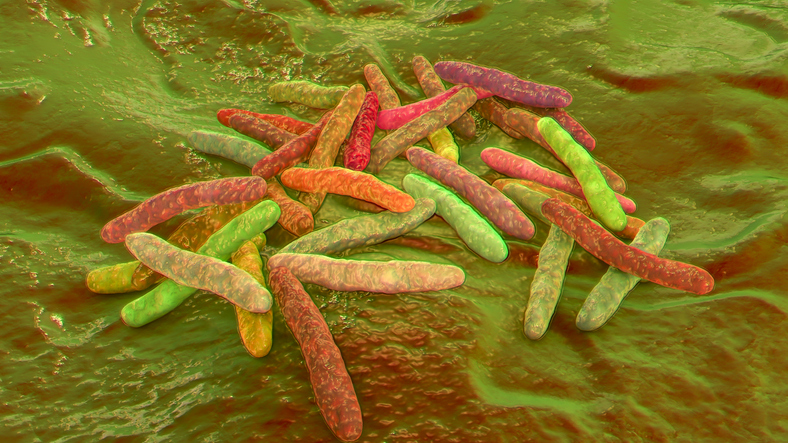More than 10 million people develop tuberculosis (TB) each year, yet about 40% go undiagnosed. The main culprit is reliance on sputum-based testing, which many patients—particularly those who are asymptomatic—cannot provide, and which is difficult to collect in low-resource settings. A new CRISPR-based test from Tulane University aims to close that gap by detecting Mycobacterium tuberculosis (Mtb) DNA from a simple tongue swab.
The assay, called ActCRISPR-TB, integrates isothermal amplification and CRISPR-Cas12a detection in a single “one-pot” reaction. In under an hour, it can flag infection with a paper strip readout similar to a home COVID-19 test. In a Nature Communications study titled, “Sensitive pathogen DNA detection by a multi-guide RNA Cas12a assay favoring trans- versus cis-cleavage,” the test identified TB in 74% of tongue swab samples—outperforming traditional testing methods, which reached only 56% sensitivity on the same specimens. Sensitivity was even higher for respiratory samples (93%), pediatric stool (83%), and adult spinal fluid (93%), underscoring its potential to diagnose TB in patients who cannot provide sputum.
“For TB diagnostics, we need point-of-care technology because TB is a disease related to poverty,” lead author Zhen Huang, PhD, assistant professor at Tulane University School of Medicine, told GEN. He added that most TB cases occur in remote areas with limited resources. “…we have to use the point-of-care to increase the accessibility for TB diagnostics.”
Filling the sputum gap
Traditional TB tests depend on mucus collected from the lungs, but sputum testing is impossible in roughly 25% of symptomatic patients and nearly 90% of asymptomatic ones. That leaves millions undetected and untreated, allowing the disease to spread. By focusing on easily collected oral samples, ActCRISPR-TB could enable large-scale screening campaigns in communities where trained medical staff and laboratory infrastructure are scarce.
The technology builds on the team’s earlier two-step CRISPR assay, which detected Mycobacterium tuberculosis cell-free DNA in blood with high sensitivity and specificity, even identifying extrapulmonary and pediatric cases missed by sputum-based diagnostics—but streamlines the process into a single tube, reducing contamination risk and equipment needs. The team validated the new method in more than 600 clinical specimens across multiple sample types, including “adult respiratory, pediatric stool, and adult cerebral spinal fluid specimens,” the authors wrote.
ActCRISPR-TB uses guide RNAs that favor trans-cleavage activity, and the authors wrote “that sensitivity could be further enhanced by the use of Cas12a RNPs targeting distinct sites on their target amplicon.” A tongue swab is added to a tube preloaded with reagents and a lateral-flow test strip. After 45 minutes of incubation at about body temperature, colored bands reveal a positive or negative result—no specialized instrumentation required.
The team has currently resolved the two key challenges of complexity and contamination, Huang explained. “In the paper, we compared our assay with other CRISPR assays for TB diagnostics.”
Broader potential
Huang and colleagues envision expanding the platform beyond tuberculosis.
“I think there is a potential to integrate AI into our system,” Huang said. “If we can use AI to help us screen, we can find more efficient…systems for other pathogens.” It means that we can quickly expand the assay from TB to other pathogens, especially for emergency diseases such as COVID-19…[or] monkeypox.”
Looking ahead
While the proof-of-concept results are promising, larger community-based studies will be needed to confirm performance in real-world screening—particularly among asymptomatic individuals with very low bacterial loads. The authors caution that tongue swabs still face hurdles. In their trial, 26% of tuberculosis cases that were positive by sputum testing produced negative tongue-swab results. They noted that M. tuberculosis DNA levels are typically lower on the tongue and can fluctuate with sampling technique, disease burden, infection site, and even everyday activities that affect “respiratory material transfer to and depletion from the oral cavity.” Such variability, they added, “can complicate the translation of swab-based diagnostics into clinical practice,” though lessons from COVID-19 testing—such as repeat testing or using more homogeneous saliva samples—may help address these challenges.
By eliminating the need for sputum and expensive equipment, ActCRISPR-TB could offer a path to earlier detection and treatment—critical steps toward the global goal of ending TB.

